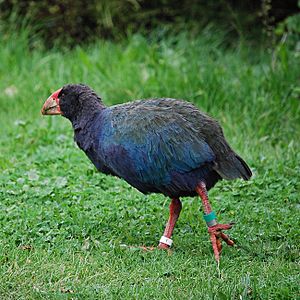Takahē facts for kids
Quick facts for kids Takahē |
|
|---|---|
 |
|
| On Tiritiri Matangi Island | |
| Conservation status | |
 Nationally Vulnerable (NZ TCS) |
|
| Scientific classification | |
| Genus: |
Porphyrio
|
| Species: |
hochstetteri
|
 |
|
| Distribution of South Island takahe, including sanctuaries | |
| Synonyms | |
|
|
The Takahē (Porphyrio hochstetteri) is a very special flightless bird from New Zealand. It belongs to the rail family, which usually includes birds that can fly. For many years, people thought the Takahē was extinct. The last four known birds were seen in 1898. But then, something amazing happened! After a careful search, the Takahē was rediscovered by Geoffrey Orbell on November 20, 1948. He found them near Lake Te Anau in the Murchison Mountains on the South Island. The scientific name hochstetteri honors the Austrian geologist Ferdinand von Hochstetter.
Contents
What is a Takahē?
The Takahē is one of the largest members of the rail family. It is known for its bright, colorful feathers. An adult Takahē is mainly purple-blue. It has a greenish back and inner wings. Its strong, red beak is very noticeable. It also has sturdy red legs.
A Bird That Can't Fly
Unlike most birds, the Takahē cannot fly. Its wings are too small and its body is too heavy. This means it has to find all its food on the ground. Being flightless made it very vulnerable to new predators. These predators arrived in New Zealand with humans.
Where Do Takahē Live?
Takahē naturally live in the South Island of New Zealand. They prefer alpine grasslands. These are high-up areas with tussock grasses. They also live in forests near these grasslands. Today, many Takahē live in special protected areas. These places are called sanctuaries. They help keep the birds safe from danger.
What Do Takahē Eat?
Takahē are mostly herbivores. This means they eat plants. Their favorite food is the base of tussock grasses. They use their strong beaks to pull up the grass. Then they strip off the tough outer leaves. They eat the soft, juicy inner part. They also eat seeds, insects, and other plants.
The Big Rediscovery
For 50 years, people believed the Takahē was gone forever. Scientists searched for them but found nothing. Then, in 1948, Dr. Geoffrey Orbell led a new search. His team explored the remote Murchison Mountains. This area was very hard to reach. They found a small group of Takahē. This discovery was a huge surprise to the world! It gave hope that other "lost" species could be found.
Life Cycle of a Takahē
Takahē usually lay one to three eggs. They build their nests on the ground. Both parents help to incubate the eggs. This means they keep the eggs warm until they hatch. The chicks hatch after about 30 days. Young Takahē stay with their parents for a long time. They learn how to find food and survive. They can live for 16 to 22 years in the wild.
Helping Takahē Survive
After their rediscovery, the Takahē population was very small. There were only a few hundred birds left. Conservation efforts began to save them. Scientists moved some Takahē to predator-free islands. These islands are like safe havens. They also breed Takahē in captivity. This helps increase their numbers. Then, these birds are released back into the wild. Thanks to these efforts, the Takahē population is slowly growing. It is still an endangered species. But there is hope for its future.
Images for kids
-
Ringed female takahē at Kapiti Island.
-
Takahē released at Maungatautari Restoration Project ecological island, Waikato district, North Island in June 2006.
See also
 In Spanish: Calamón takahe para niños
In Spanish: Calamón takahe para niños







